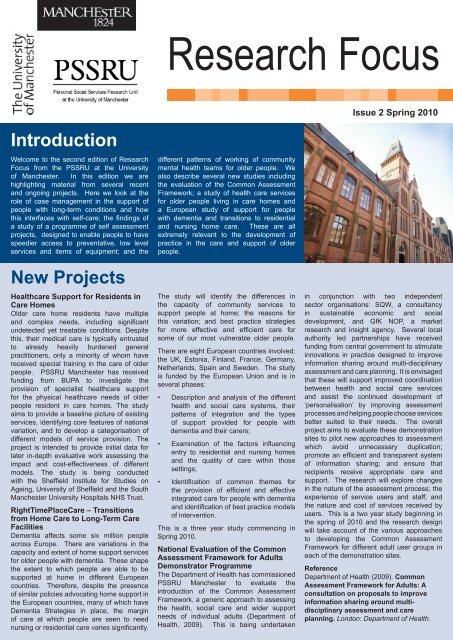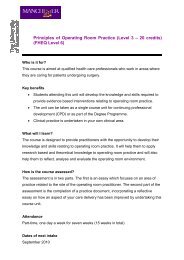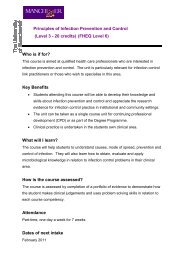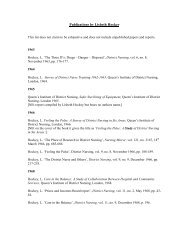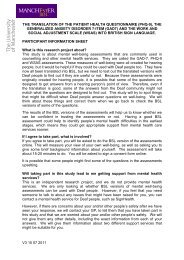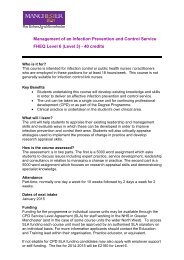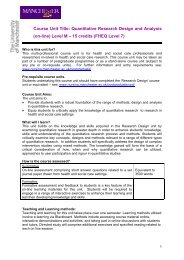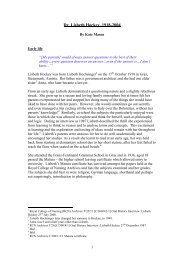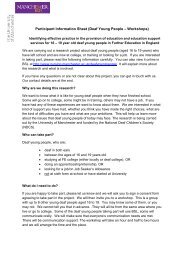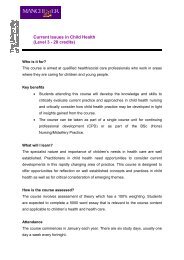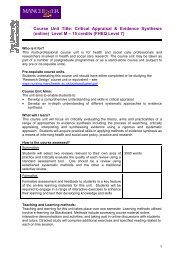Research Focus - School of Nursing, Midwifery and Social Work ...
Research Focus - School of Nursing, Midwifery and Social Work ...
Research Focus - School of Nursing, Midwifery and Social Work ...
Create successful ePaper yourself
Turn your PDF publications into a flip-book with our unique Google optimized e-Paper software.
<strong>Research</strong> <strong>Focus</strong><br />
Issue 2 Spring 2010<br />
Introduction<br />
Welcome to the second edition <strong>of</strong> <strong>Research</strong><br />
<strong>Focus</strong> from the PSSRU at the University<br />
<strong>of</strong> Manchester. In this edition we are<br />
highlighting material from several recent<br />
<strong>and</strong> ongoing projects. Here we look at the<br />
role <strong>of</strong> case management in the support <strong>of</strong><br />
people with long-term conditions <strong>and</strong> how<br />
this interfaces with self-care; the findings <strong>of</strong><br />
a study <strong>of</strong> a programme <strong>of</strong> self assessment<br />
projects, designed to enable people to have<br />
speedier access to preventative, low level<br />
services <strong>and</strong> items <strong>of</strong> equipment; <strong>and</strong> the<br />
New Projects<br />
Healthcare Support for Residents in<br />
Care Homes<br />
Older care home residents have multiple<br />
<strong>and</strong> complex needs, including significant<br />
undetected yet treatable conditions. Despite<br />
this, their medical care is typically entrusted<br />
to already heavily burdened general<br />
practitioners, only a minority <strong>of</strong> whom have<br />
received special training in the care <strong>of</strong> older<br />
people. PSSRU Manchester has received<br />
funding from BUPA to investigate the<br />
provision <strong>of</strong> specialist healthcare support<br />
for the physical healthcare needs <strong>of</strong> older<br />
people resident in care homes. The study<br />
aims to provide a baseline picture <strong>of</strong> existing<br />
services, identifying core features <strong>of</strong> national<br />
variation, <strong>and</strong> to develop a categorisation <strong>of</strong><br />
different models <strong>of</strong> service provision. The<br />
project is intended to provide initial data for<br />
later in-depth evaluative work assessing the<br />
impact <strong>and</strong> cost-effectiveness <strong>of</strong> different<br />
models. The study is being conducted<br />
with the Sheffield Institute for Studies on<br />
Ageing, University <strong>of</strong> Sheffield <strong>and</strong> the South<br />
Manchester University Hospitals NHS Trust.<br />
RightTimePlaceCare – Transitions<br />
from Home Care to Long-Term Care<br />
Facilities<br />
Dementia affects some six million people<br />
across Europe. There are variations in the<br />
capacity <strong>and</strong> extent <strong>of</strong> home support services<br />
for older people with dementia. These shape<br />
the extent to which people are able to be<br />
supported at home in different European<br />
countries. Therefore, despite the presence<br />
<strong>of</strong> similar policies advocating home support in<br />
the European countries, many <strong>of</strong> which have<br />
Dementia Strategies in place, the margin<br />
<strong>of</strong> care at which people are seen to need<br />
nursing or residential care varies significantly.<br />
different patterns <strong>of</strong> working <strong>of</strong> community<br />
mental health teams for older people. We<br />
also describe several new studies including<br />
the evaluation <strong>of</strong> the Common Assessment<br />
Framework; a study <strong>of</strong> health care services<br />
for older people living in care homes <strong>and</strong><br />
a European study <strong>of</strong> support for people<br />
with dementia <strong>and</strong> transitions to residential<br />
<strong>and</strong> nursing home care. These are all<br />
extremely relevant to the development <strong>of</strong><br />
practice in the care <strong>and</strong> support <strong>of</strong> older<br />
people.<br />
The study will identify the differences in<br />
the capacity <strong>of</strong> community services to<br />
support people at home; the reasons for<br />
this variation; <strong>and</strong> best practice strategies<br />
for more effective <strong>and</strong> efficient care for<br />
some <strong>of</strong> our most vulnerable older people.<br />
There are eight European countries involved:<br />
the UK, Estonia, Finl<strong>and</strong>, France, Germany,<br />
Netherl<strong>and</strong>s, Spain <strong>and</strong> Sweden. The study<br />
is funded by the European Union <strong>and</strong> is in<br />
several phases:<br />
• Description <strong>and</strong> analysis <strong>of</strong> the different<br />
health <strong>and</strong> social care systems, their<br />
patterns <strong>of</strong> integration <strong>and</strong> the types<br />
<strong>of</strong> support provided for people with<br />
dementia <strong>and</strong> their carers;<br />
• Examination <strong>of</strong> the factors influencing<br />
entry to residential <strong>and</strong> nursing homes<br />
<strong>and</strong> the quality <strong>of</strong> care within those<br />
settings;<br />
• Identification <strong>of</strong> common themes for<br />
the provision <strong>of</strong> efficient <strong>and</strong> effective<br />
integrated care for people with dementia<br />
<strong>and</strong> identification <strong>of</strong> best practice models<br />
<strong>of</strong> intervention.<br />
This is a three year study commencing in<br />
Spring 2010.<br />
National Evaluation <strong>of</strong> the Common<br />
Assessment Framework for Adults<br />
Demonstrator Programme<br />
The Department <strong>of</strong> Health has commissioned<br />
PSSRU Manchester to evaluate the<br />
introduction <strong>of</strong> the Common Assessment<br />
Framework, a generic approach to assessing<br />
the health, social care <strong>and</strong> wider support<br />
needs <strong>of</strong> individual adults (Department <strong>of</strong><br />
Health, 2009). This is being undertaken<br />
in conjunction with two independent<br />
sector organisations: SQW, a consultancy<br />
in sustainable economic <strong>and</strong> social<br />
development, <strong>and</strong> GfK NOP, a market<br />
research <strong>and</strong> insight agency. Several local<br />
authority led partnerships have received<br />
funding from central government to stimulate<br />
innovations in practice designed to improve<br />
information sharing around multi-disciplinary<br />
assessment <strong>and</strong> care planning. It is envisaged<br />
that these will support improved coordination<br />
between health <strong>and</strong> social care services<br />
<strong>and</strong> assist the continued development <strong>of</strong><br />
‘personalisation’ by improving assessment<br />
processes <strong>and</strong> helping people choose services<br />
better suited to their needs. The overall<br />
project aims to evaluate these demonstration<br />
sites to pilot new approaches to assessment<br />
which avoid unnecessary duplication;<br />
promote an efficient <strong>and</strong> transparent system<br />
<strong>of</strong> information sharing; <strong>and</strong> ensure that<br />
recipients receive appropriate care <strong>and</strong><br />
support. The research will explore changes<br />
in the nature <strong>of</strong> the assessment process; the<br />
experience <strong>of</strong> service users <strong>and</strong> staff; <strong>and</strong><br />
the nature <strong>and</strong> cost <strong>of</strong> services received by<br />
users. This is a two year study beginning in<br />
the spring <strong>of</strong> 2010 <strong>and</strong> the research design<br />
will take account <strong>of</strong> the various approaches<br />
to developing the Common Assessment<br />
Framework for different adult user groups in<br />
each <strong>of</strong> the demonstration sites.<br />
Reference<br />
Department <strong>of</strong> Health (2009). Common<br />
Assessment Framework for Adults: A<br />
consultation on proposals to improve<br />
information sharing around multidisciplinary<br />
assessment <strong>and</strong> care<br />
planning. London: Department <strong>of</strong> Health.
Self Assessment<br />
PSSRU recently completed a Department<br />
<strong>of</strong> Health funded evaluation <strong>of</strong> the efficiency<br />
<strong>and</strong> effectiveness <strong>of</strong> self assessment in<br />
community care. Self assessment is not a<br />
new phenomenon. However, the introduction<br />
<strong>of</strong> the personalisation agenda, combined with<br />
the continued drive towards efficiency <strong>and</strong><br />
cost-effectiveness in social care, means that<br />
self assessment has become increasingly<br />
attractive to policy makers <strong>and</strong> service<br />
providers alike.<br />
The project evaluated thirteen projects across<br />
eleven English local authorities selected by the<br />
Department <strong>of</strong> Health as pilot sites. Spanning<br />
a range <strong>of</strong> services <strong>and</strong> service contexts,<br />
these varied in the way they conceptualised<br />
<strong>and</strong> operationalised self assessment. This<br />
heterogeneity was reflected in the research<br />
design: a pragmatic programme evaluation,<br />
whose aim was not only to assess the<br />
effectiveness <strong>of</strong> the specific initiatives, but<br />
also to describe <strong>and</strong> clarify the meanings <strong>and</strong><br />
practices associated with self assessment<br />
within the social care setting. The research<br />
addressed several key themes <strong>and</strong> questions:<br />
1. How does self assessment fit into<br />
existing service structures?<br />
Self assessment may be particularly suited to<br />
three key service areas: preventative services,<br />
designed to facilitate the recent ‘strategic shift<br />
to early intervention’ (DH, 2008, p2); traditional<br />
occupational therapy departments who are<br />
currently shifting to a more ‘retail model’ <strong>of</strong><br />
service delivery; <strong>and</strong> as part <strong>of</strong> the authorities’<br />
formal assessment <strong>and</strong> care management<br />
arrangements, in which the need for a more<br />
differentiated approach is being increasingly<br />
recognised. Reflecting recent policy<br />
guidance, a number <strong>of</strong> the projects had also<br />
been developed in conjunction with voluntary<br />
agencies. An important aim <strong>of</strong> the research<br />
was to produce a classification, or typology, <strong>of</strong><br />
self assessment. This distinguished four goals<br />
or ‘types’ <strong>of</strong> self assessment, each occupying<br />
a different position within existing assessment<br />
arrangements. It had been expected that<br />
a spread <strong>of</strong> ‘types’ would be found across<br />
the thirteen sites. However, as shown in<br />
Table 1, ten <strong>of</strong> the projects (all located within<br />
occupational therapy or preventative services)<br />
were designed primarily to facilitate direct<br />
access to equipment or services (type 3),<br />
while the remaining three contributed directly<br />
to the wider assessment process (type 2).<br />
Although a number <strong>of</strong> projects identified<br />
screening or long-term care planning as<br />
Type <strong>of</strong> Self Assessment<br />
1. Screening/casefinding:<br />
Self assessment as a means <strong>of</strong> identifying those for whom further<br />
pr<strong>of</strong>essional contact/assessment is appropriate<br />
2. Contributing to the wider assessment process:<br />
Self assessment as an element in a broader, more complex process<br />
<strong>of</strong> assessment in which pr<strong>of</strong>essionals continue to play a central role<br />
3. Facilitating direct access to equipment/services:<br />
Self assessment as a mechanism for accessing equipment/<br />
services directly, by-passing the requirement for assessment by a<br />
pr<strong>of</strong>essional<br />
4. Contributing to service planning:<br />
Self assessment as part <strong>of</strong> the on-going process <strong>of</strong> care planning<br />
Table 1: Type <strong>of</strong> Self Assessment<br />
secondary functions, the findings suggest that<br />
these aspects <strong>of</strong> self assessment have yet to<br />
be developed within social care.<br />
2. Uses, cases <strong>and</strong> efficacy: who gets what<br />
– <strong>and</strong> when?<br />
Data on the characteristics <strong>and</strong> circumstances<br />
<strong>of</strong> self assessees revealed that the average<br />
person undergoing self assessment was<br />
female, over 75, white, in poor or fair health,<br />
but still relatively independent in terms <strong>of</strong><br />
activities <strong>of</strong> daily living. Significantly, they<br />
also tended to be slightly healthier <strong>and</strong> less<br />
dependent than the recipients <strong>of</strong> traditional<br />
face-to-face assessments. The majority <strong>of</strong><br />
projects focused on the delivery <strong>of</strong> community<br />
equipment <strong>and</strong> adaptations. Most – though<br />
not all – <strong>of</strong> the items obtained through self<br />
assessment were at the lower end <strong>of</strong> the<br />
cost spectrum, in contrast to traditional<br />
assessments which led to a wider <strong>and</strong><br />
more customised range <strong>of</strong> equipment <strong>and</strong><br />
adaptations. The period between referral <strong>and</strong><br />
assessment was usually much shorter for self<br />
assessees than their traditional counterparts<br />
but, disappointingly, this did not necessarily<br />
translate into faster service receipt.<br />
3. How acceptable <strong>and</strong> cost efficient is self<br />
assessment?<br />
A key component <strong>of</strong> the research was the<br />
user experience survey, which was conducted<br />
among both self <strong>and</strong> traditional assessees.<br />
Interestingly, there were no overall differences<br />
between self <strong>and</strong> traditional assessees, with<br />
both groups finding the assessment easy<br />
to complete <strong>and</strong> expressing high levels <strong>of</strong><br />
satisfaction with the experience. However, self<br />
assessments conducted on-line were found<br />
to be generally less acceptable, while certain<br />
user groups, particularly people from Asian<br />
backgrounds, or those suffering from memory,<br />
mood or marked health problems, found self<br />
assessment particularly problematic. The<br />
costs <strong>of</strong> the individual projects were also<br />
calculated <strong>and</strong> cost-effectiveness analyses<br />
Primary purpose<br />
(N <strong>of</strong> sites)<br />
Secondary purpose<br />
(N <strong>of</strong> sites)<br />
0 3<br />
3 2<br />
10 1<br />
0 2<br />
conducted by comparing costs / savings with<br />
user satisfaction scores. Although the majority<br />
<strong>of</strong> projects resulted in some savings (mainly in<br />
relation to pr<strong>of</strong>essional staff’s time) only two<br />
were deemed to be definitely cost-effective<br />
i.e less costly <strong>and</strong> more acceptable.<br />
4. Implementation <strong>and</strong> sustainability<br />
A final aim <strong>of</strong> the research was to evaluate<br />
the actual process <strong>of</strong> implementation <strong>and</strong> the<br />
transition from pilot project to mainstream<br />
practice. The key message which emerged<br />
from the in-depth interviews with managers<br />
was that, to be successful, projects needed to<br />
be embedded in practice. The actual scale <strong>of</strong><br />
the change was thus less important than the<br />
degree <strong>of</strong> broad strategic fit – both internally,<br />
in terms <strong>of</strong> whether self assessment was<br />
integral to the department’s ‘core business’<br />
<strong>and</strong> could utilise existing structures <strong>and</strong><br />
practices; <strong>and</strong> externally, in relation to the<br />
wider agenda <strong>of</strong> the organisation. Inevitably,<br />
the long-term future <strong>of</strong> the projects was<br />
dependent on higher level managerial <strong>and</strong><br />
political support, <strong>and</strong> managers were acutely<br />
aware <strong>of</strong> the need to demonstrate success<br />
(in terms <strong>of</strong> either efficiency or popularity with<br />
service users) within a short timescale. Some<br />
were also keen that their project should serve<br />
as a catalyst for wider organisational change,<br />
using the lessons they had learned to develop<br />
more accessible, person-centred services<br />
across the authority.<br />
Overall, while the research suggests that self<br />
assessment has a role to play in the newly<br />
emergent configuration <strong>of</strong> care services, it is<br />
still in its infancy. Findings suggest that while<br />
it can improve access to certain services -<br />
particularly equipment <strong>and</strong> adapations - it has<br />
not been employed in areas where it has been<br />
in healthcare, such as screening.<br />
Reference<br />
Department <strong>of</strong> Health (2008). Transforming<br />
<strong>Social</strong> Care, LAC (DH) . London: Department<br />
<strong>of</strong> Health<br />
The Personal <strong>Social</strong> Services <strong>Research</strong> Unit was<br />
established in 1974 <strong>and</strong> now has branches at three UK<br />
universities: the University <strong>of</strong> Kent, the London <strong>School</strong> <strong>of</strong><br />
Economics <strong>and</strong> Political Science, <strong>and</strong> the University <strong>of</strong><br />
Manchester.<br />
Its mission is to conduct high quality research on social<br />
<strong>and</strong> health care to inform <strong>and</strong> influence policy, practice<br />
<strong>and</strong> theory.
“How Does Your Team <strong>Work</strong>?” A National Survey <strong>of</strong><br />
Community Mental Health Teams for Older People<br />
Community Mental Health Teams for Older<br />
People (CMHTsOP) form the cornerstone <strong>of</strong><br />
specialist services aiming to diagnose, treat<br />
<strong>and</strong> care for older people with all forms <strong>of</strong><br />
mental health problems in their own homes.<br />
Their importance has been highlighted in<br />
a range <strong>of</strong> government policies over the<br />
last decade, from the National Service<br />
Framework (NSF) for Older People to the<br />
more recent National Dementia Strategy.<br />
The PSSRU has been commissioned by<br />
the National Institute for Health <strong>Research</strong> to<br />
investigate the national variation in CMHTsOP<br />
composition <strong>and</strong> structure, as the first part <strong>of</strong><br />
a wider programme <strong>of</strong> research assessing the<br />
relative merits <strong>of</strong> different team approaches.<br />
In late 2008 we conducted a postal survey <strong>of</strong><br />
all relevant teams in Engl<strong>and</strong>, covering the<br />
following domains: team characteristics, staff<br />
composition <strong>and</strong> responsibilities, key team<br />
processes, <strong>and</strong> outreach <strong>and</strong> liaison work. The<br />
response rate was 88 percent (376 teams).<br />
Selected findings<br />
The questionnaire collected information on<br />
CMHTs staffing, including data on “core”<br />
<strong>and</strong> “sessional” team members: the former<br />
defined as devoting a substantial proportion<br />
<strong>of</strong> their working week to the team’s work, with<br />
the latter contributing a regular (but smaller)<br />
part <strong>of</strong> their time. The ‘average’ team had 16<br />
core members, but, reflecting diversity in team<br />
size, almost a quarter <strong>of</strong> teams had fewer than<br />
10 core members, <strong>and</strong> a similar proportion<br />
again had more than 20. Figure 1 shows team<br />
membership amongst those pr<strong>of</strong>essional<br />
disciplines that are regarded as central to a<br />
successful CMHTOP. As expected, almost<br />
every team had core Community Mental<br />
Health Nurses, <strong>and</strong> over 80 percent <strong>of</strong><br />
teams had core support workers, OTs <strong>and</strong><br />
consultants. Whilst it is unsurprising in the light<br />
<strong>of</strong> previous research that psychology input is<br />
less than universal <strong>and</strong> less well integrated,<br />
it is noteworthy that social workers, too, are<br />
not found in every team. Beyond staffing, we<br />
collected information that enabled a closer look<br />
at team integration, a theme that has attracted<br />
much policy attention in recent years. Figure<br />
2 shows the proportion <strong>of</strong> teams achieving<br />
each <strong>of</strong> nine indicators <strong>of</strong> joint working, each<br />
<strong>of</strong> which has been recommended in key<br />
policy literature. The chart shows that over 80<br />
percent <strong>of</strong> all teams had (<strong>and</strong> used) a single<br />
point <strong>of</strong> access, shared a common <strong>of</strong>fice base,<br />
<strong>and</strong> used single joint care plans across health<br />
<strong>and</strong> social care services. Over two-thirds<br />
<strong>of</strong> teams also used the same assessment<br />
documentation between all pr<strong>of</strong>essional<br />
disciplines. Sixty percent <strong>of</strong> teams were<br />
multidisciplinary (defined as having at least<br />
a social worker <strong>and</strong> two health workers as<br />
core team members) <strong>and</strong> the same proportion<br />
used a single key worker for coordinating<br />
the care across different agencies. Fifty<br />
percent <strong>of</strong> CMHTs reported that all core<br />
members were directly line managed within<br />
the team. However fewer than a third <strong>of</strong><br />
teams (32%) reported that their CMHT <strong>and</strong><br />
social services teams shared service user<br />
records where appropriate, <strong>and</strong> even those<br />
that did <strong>of</strong>ten noted that this was not a simple<br />
process. Finally, just 57 teams across the<br />
country (15%) stated that health staff within<br />
the team were able to commission social<br />
care services directly. We also asked open<br />
questions about the positive <strong>and</strong> negative<br />
characteristics <strong>of</strong> teams. The most frequent<br />
positive comments were about the rewarding<br />
experience <strong>of</strong> team working (29%), followed<br />
by the quality <strong>of</strong> the staff (21%) <strong>and</strong> the quality<br />
<strong>of</strong> the inter-pr<strong>of</strong>essional relationships (16%).<br />
In contrast, the most commonly mentioned<br />
negative characteristics related to a general<br />
lack <strong>of</strong> integration (16%), referral arrangements<br />
(13%) <strong>and</strong> problems accessing information<br />
from other agencies, including the difficulties<br />
caused by incompatable computer systems<br />
(12%). These views <strong>of</strong> team managers seem<br />
to highlight the potential <strong>of</strong> integrated teams<br />
as well as confirm that full service integration<br />
has not yet been universally achieved.<br />
This study has highlighted a significant<br />
diversity in CMHTsOP structure <strong>and</strong> practice<br />
across Engl<strong>and</strong>. Teams range in style from<br />
small teams with just a few core members,<br />
to services with 30 or more staff, sometimes<br />
incorporating a wider range <strong>of</strong> services such<br />
as a memory clinic or a home treatment team<br />
in addition to the CMHT itself. This wide<br />
variety <strong>of</strong> team styles begs the question:<br />
does it matter? Do some CMHT structures<br />
<strong>and</strong> approaches improve service user<br />
care more than others? If so, which? Are<br />
there team “models” that CMHTs should<br />
adopt? This survey cannot answer these<br />
questions, but it forms the platform on which<br />
the next phase <strong>of</strong> this research programme<br />
will be built, which will form an exploratory<br />
study investigating these important issues.<br />
100<br />
100<br />
75<br />
75<br />
% 50<br />
Core member<br />
Sessional member<br />
%<br />
50<br />
25<br />
25<br />
0<br />
0<br />
CMHNs<br />
Support<br />
workers<br />
OTs<br />
Consultants<br />
<strong>Social</strong> workers<br />
Psychologists<br />
Single point <strong>of</strong><br />
access<br />
Share a<br />
common base<br />
Single care plan<br />
Same<br />
assessment<br />
docs<br />
Multidisciplinary<br />
team<br />
Integrated carecoordinator<br />
Core staff<br />
managed in<br />
team<br />
Shared access<br />
to records<br />
Health staff<br />
comm. LA serv<br />
Figure 1: Team membership by pr<strong>of</strong>essional discipline<br />
Figure 2: Teams attaining nine indicators <strong>of</strong> joint working<br />
Recent Publications<br />
• Abell J, Hughes J, Reilly S, Berzins K <strong>and</strong><br />
Challis D. (2010). Case Management<br />
for Long Term Conditions: The Role<br />
<strong>of</strong> Networks in Health <strong>and</strong> <strong>Social</strong> Care<br />
Services. Journal <strong>of</strong> Integrated Care, 18,<br />
45-52.<br />
• Abendstern M, Hughes J, Clarkson P,<br />
Sutcliffe C, Wilson K <strong>and</strong> Challis D. (2010).<br />
‘We need to talk’: communication<br />
between primary care trusts <strong>and</strong><br />
other health <strong>and</strong> social care agencies<br />
following the introduction <strong>of</strong> the Single<br />
Assessment Process for older people in<br />
Engl<strong>and</strong>. Primary Health Care <strong>Research</strong><br />
<strong>and</strong> Development, 11, 61-71.<br />
• Clarkson P, Challis D, Davies S, Donnelly M,<br />
Beech R <strong>and</strong> Hirano T. (2010). Comparing<br />
how to compare: an evaluation <strong>of</strong><br />
alternative performance measurement<br />
systems in the field <strong>of</strong> social care.<br />
Evaluation, 16, 59-79.<br />
• Challis D, Hughes J, Berzins K, Reilly<br />
S, Abell J <strong>and</strong> Stewart K. (2010).<br />
Self care <strong>and</strong> case management in<br />
long term conditions: the effective<br />
management <strong>of</strong> critical interfaces.<br />
doi:http://www.sdo.nihr.ac.uk/projdetails.<br />
php?ref=08-1715-201
Case Management <strong>and</strong> Self-care in Long-term Conditions<br />
The purpose <strong>of</strong> this study was to explore<br />
the role <strong>of</strong> case management <strong>and</strong> self-care<br />
within the NHS <strong>and</strong> social care model for<br />
improving care for people with long-term<br />
conditions. It has been estimated that this<br />
affects a large number who are significant<br />
users <strong>of</strong> healthcare resources. Self-care has<br />
been identified as integral to the maintenance<br />
<strong>of</strong> health <strong>and</strong> well-being for people with longterm<br />
conditions. Policy guidance recommends<br />
that patients receive help appropriate to their<br />
level <strong>of</strong> need: supported self-care; disease<br />
care management or case management. The<br />
role <strong>of</strong> community matron has been developed<br />
to undertake the case management role<br />
<strong>and</strong> within this assess the extent to which<br />
self-care support services might contribute<br />
to patient welfare. This study comprised: a<br />
literature review; a national survey <strong>of</strong> case<br />
management <strong>and</strong> self-care arrangements; <strong>and</strong><br />
interviews <strong>and</strong> focus groups in four services.<br />
Additionally, older people commented on the<br />
principal research findings.<br />
A majority <strong>of</strong> case management services<br />
were targeted at people with chronic<br />
obstructive pulmonary disease, coronary<br />
heart disease, diabetes or multiple conditions,<br />
typically identified via a referral from other<br />
pr<strong>of</strong>essionals, a case finding tool or via local<br />
implementation <strong>of</strong> the Single Assessment<br />
Process. All services undertook the<br />
assessment <strong>of</strong> health <strong>and</strong> social care needs<br />
but fewer undertook care planning <strong>and</strong> service<br />
allocation, monitoring <strong>and</strong> review, together with<br />
associated financial management tasks within<br />
the case management process. Additionally,<br />
some case managers also provided patient<br />
advocacy, emotional support <strong>and</strong> h<strong>and</strong>s<br />
on care as well as conducting medication<br />
reviews. Together these findings suggest:<br />
considerable variation in case management<br />
arrangements; a different emphasis in the case<br />
management process compared with local<br />
authority care management arrangements<br />
(Challis et al., 2007); as well as greater clarity<br />
in the identification <strong>of</strong> their target population.<br />
The improvement <strong>of</strong> the extent <strong>and</strong> scope<br />
<strong>of</strong> services <strong>and</strong> the overall coordination <strong>of</strong><br />
care to people living in the community were<br />
widely reported service objectives. Our study<br />
revealed that links between case management<br />
100<br />
75<br />
% 50<br />
25<br />
0<br />
Nurse team in<br />
primary health<br />
care<br />
Figure 3: Location <strong>of</strong> staff<br />
services for people with long-term conditions<br />
were most developed with other services<br />
provided by Primary Care Trusts, particularly<br />
community nursing services, reflecting their<br />
shared management structure <strong>and</strong> <strong>of</strong>ten<br />
their co-location (Figure 3). In contrast links<br />
with local authority social care services,<br />
reflected in joint initiatives <strong>and</strong> working<br />
practices, were more variable <strong>and</strong> most <strong>of</strong>ten<br />
reported in the use <strong>of</strong> shared assessment<br />
documentation. Similarly there was evidence<br />
<strong>of</strong> variation in working relationships with<br />
general practitioners but overall indications <strong>of</strong><br />
burgeoning relationships. In both settings colocation<br />
was a significant factor in promoting<br />
working relationships.<br />
Self-care support was an explicit goal<br />
for the majority <strong>of</strong> long-term conditions<br />
services represented in our study. Within<br />
localities the most frequently reported were<br />
generic courses, such as the Expert Patient<br />
Programme; condition specific groups; <strong>and</strong><br />
advice <strong>and</strong> information. More generally,<br />
the type <strong>of</strong> support valued by people varied<br />
according to specific long-term conditions,<br />
their severity <strong>and</strong> individual choice. In the<br />
long-term conditions service there were<br />
indications that education <strong>and</strong> guidance in<br />
respect <strong>of</strong> self-care was part <strong>of</strong> the support<br />
patients received from case managers,<br />
although it was <strong>of</strong>ten not explicitly recognised<br />
as such. It was also suggested that <strong>of</strong>ten<br />
GP practices<br />
Health <strong>and</strong><br />
social care<br />
integrated<br />
team<br />
Hospital <strong>and</strong><br />
intermediate<br />
care services<br />
Local authority<br />
social care<br />
services team<br />
patients receiving case management<br />
experienced limited mobility <strong>and</strong> were<br />
generally frail, preventing them from<br />
participating in self-care support groups.<br />
Overall, the case management services<br />
reviewed were relatively new <strong>and</strong> considerable<br />
variation in approach was evident across<br />
the country, mirroring earlier developments<br />
in local authority care management<br />
arrangements. A key difference was that the<br />
case management service was more clearly<br />
targeted on those with the most complex<br />
needs. Being a nurse-led service, links within<br />
the primary care sector were strong, reflecting<br />
its origins. However, there were poorer links<br />
with both other health services <strong>and</strong> social<br />
care, although examples <strong>of</strong> pilot initiatives to<br />
promote joint working were found. Self-care<br />
initiatives existed within localities but they<br />
were not always accessible to case managed<br />
patients. Some case managers provided<br />
self-care support, such as patient education,<br />
through their routine contact with patients.<br />
Reference<br />
Challis D, Hughes J, Jacobs S, Stewart K<br />
<strong>and</strong> Weiner K. (2007). Are different forms<br />
<strong>of</strong> care management for older people in<br />
Engl<strong>and</strong> associated with variations in<br />
case-mix, service use <strong>and</strong> care managers’<br />
time use? Ageing <strong>and</strong> Society, 27, 25-48.<br />
Contact Details<br />
Asha Myers, <strong>Research</strong> Secretary<br />
T: 0161 275 5680, F: 0161 275 5790<br />
pssru@manchester.ac.uk<br />
www.medicine.manchester.ac.uk/pssru<br />
PSSRU<br />
University <strong>of</strong> Manchester<br />
Dover Street Building<br />
Oxford Road<br />
Manchester M13 9PL


